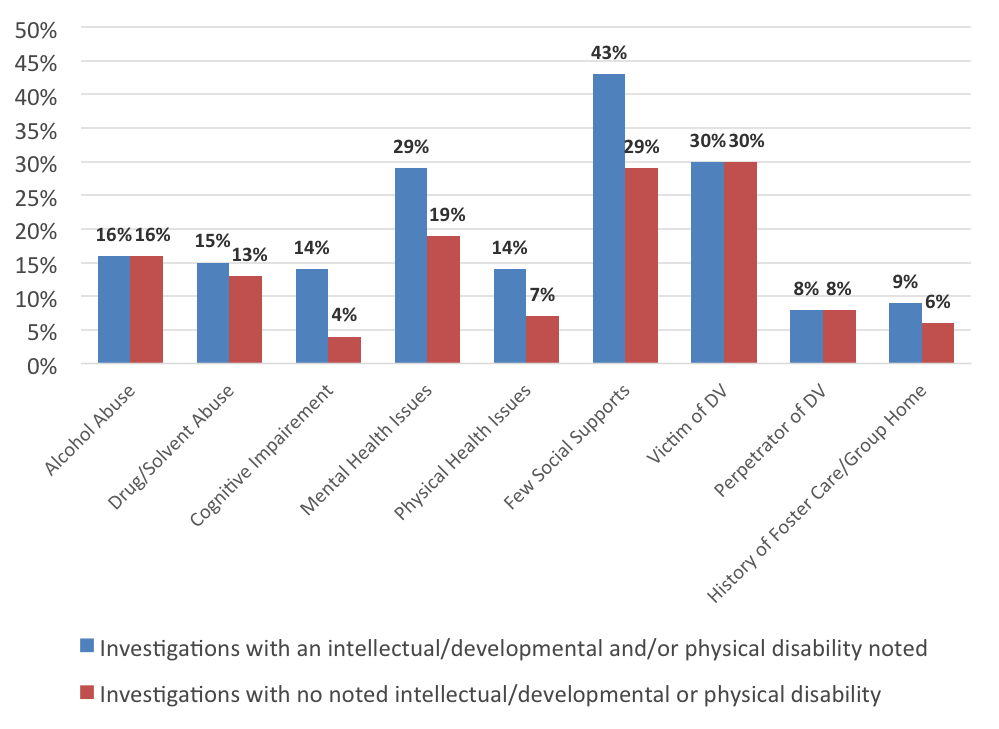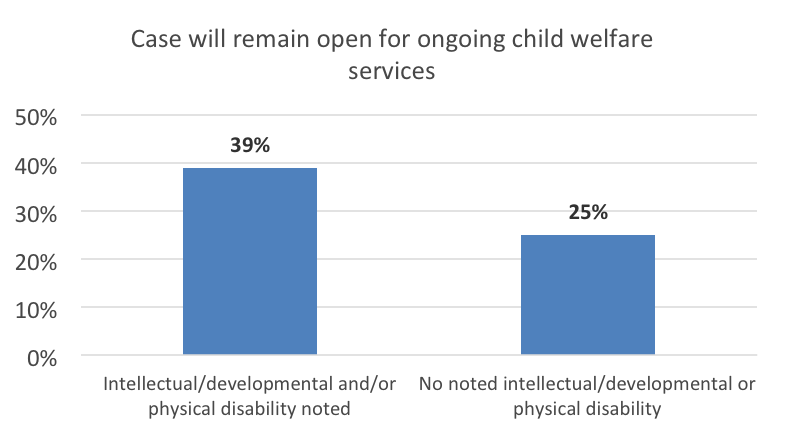Bogossian, A., MacCulloch, R., & Fallon, B. (2014). Maltreatment-Related Investigations involving Children and Youth with Disabilities in Canada in 2008. CWRP Information Sheet #133E. Montreal, QC: McGill University, Centre for Research on Children and Families.
Introduction
The Canadian Incidence Study of Reported Child Abuse and Neglect-2008 (CIS-2008) is the third nation-wide study to examine the incidence of reported child maltreatment and the characteristics of children and families investigated by child welfare authorities in Canada. In addition to the tables presented in the Major Findings Report[1], this information sheet examines investigations in which there was a noted child functioning concern of an intellectual/developmental and/or physical disability. The descriptive analyses presented in this information sheet were prepared by the authors with funding from a Social Sciences and Humanities Research Council Partnership Grant and a gift from the Royal Bank of Canada foundation to support the McGill Centre for Research on Children and Families’ Children’s Services Research and Training Program.
Findings
There were an estimated 235,842 maltreatment-related investigations conducted in Canada in 2008. An estimated 174,411 investigations were for an alleged incident of maltreatment and an estimated 61,431 were risk-only investigations. Overall, in 10.3% (an estimated 24,178 investigations) of maltreatment-related investigations, the investigating worker noted a child functioning concern of an intellectual/developmental disability, a physical disability or both. Specifically, in 9.5% of investigations (an estimated 22,394 investigations), an intellectual disability was noted, in 1.6% of investigations (an estimated 3,837 investigations), a physical disability was noted and in 0.9% of investigations (an estimated 2,053 investigations), both an intellectual/developmental and physical disability were noted.
Approximately two-thirds (64%) of children with a noted intellectual/developmental disability and/or physical disability were male (an estimated 15,500 investigations) and 36% female (an estimated 8,678 investigations). This finding is consistent with data from the 2006 Participation and Activity Limitations Survey which identified that boys (0-14) were more likely to experience all disability types than girls (0-14; Statistics Canada, 2006).
The proportion of children with a noted intellectual/developmental and/or physical disability also varies by age. Specifically, as the age category increases, so too does the proportion of investigations with a noted disability (see Figure 1). This finding is consistent with national data that indicates that disability rates steadily increase with age (Statistics Canada, 2006).
Figure 1.
Noted intellectual/developmental and/or physical disabilities by age category

Figure 2 compares primary caregiver risk factors in investigations with a noted child functioning concern of an intellectual/developmental and/or physical disability to those investigations with no noted disabilities. The following primary caregiver risk factors were more often documented in investigations with a noted child functioning concern of an intellectual/developmental and/or physical disability: drug/solvent abuse, cognitive impairment, mental health issue, physical health issue, few social supports and history of foster care/group home.
Figure 2.
Primary caregiver risk factors by noted child functioning concerns of intellectual/developmental and/or physical disability 
As shown in Figure 3 below, a greater proportion of investigations in which an intellectual/developmental and/or physical disability was noted by the investigating worker remained open for ongoing child welfare services at the conclusion of the initial investigation (39% vs. 25%).
Figure 3.
Transfers to ongoing child welfare services by noted intellectual/developmental and/or physical disabilities

Summary
In just over one tenth of maltreatment-related investigations (10.3%), the investigating worker noted an intellectual/developmental disability, a physical disability or both. A disability was more often noted for males and older youth. Six of the nine primary caregiver risk factors were more often noted in investigations in which an intellectual/developmental and/or physical disability was noted. Moreover, a greater proportion of investigations in which an intellectual/developmental and/or physical disability was noted remained open for ongoing child welfare services at the conclusion of their initial investigation.
Children and youth with intellectual and/or physical disabilities and their families who are brought to the attention of child welfare agencies in Canada may have unique service needs when compared to those children and youth without intellectual or physical disabilities and their families which may necessitate a greater need for ongoing support. As such, child welfare workers may benefit from specialized training regarding the needs of children and youth with intellectual or physical disabilities and their families and the development of sustainable partnerships between child welfare agencies and community supports.
Background
Responsibility for protecting and supporting children at risk of abuse and neglect falls under the jurisdiction of the 13 Canadian provinces and territories and a system of Aboriginal child welfare agencies which have increasing responsibility for protecting and supporting Aboriginal children. Because of variations in the types of situations that each jurisdiction includes under its child welfare mandate as well as differences in the way service statistics are kept, it is difficult to obtain a nation-wide profile of the children and families receiving child welfare services. The Canadian Incidence Study of Reported Child Abuse and Neglect (CIS) is designed to provide such a profile by collecting information on a periodic basis from every jurisdiction using a standardized set of definitions. With core funding from the Public Health Agency of Canada and in-kind and financial support from a consortium of federal, provincial, territorial, Aboriginal and academic stakeholders, the CIS-2008 is the third nation-wide study of the incidence and characteristics of investigated child abuse and neglect across Canada.
Methodology
The CIS-2008 used a multi-stage sampling design to select a representative sample of 112 child welfare agencies in Canada and then to select a sample of cases within these agencies. Information was collected directly from child welfare workers on a representative sample of 15,980 child protection investigations conducted during a three-month sampling period in the fall of 2008. This sample was weighted to reflect provincial annual estimates.
For maltreatment investigations, information was collected regarding the primary form of maltreatment investigated as well as the level of substantiation for that maltreatment. Thirty-two forms of maltreatment were listed on the data collection instrument, and these were collapsed into five broad categories: physical abuse (e.g., hit with hand), sexual abuse (e.g., exploitation), neglect (e.g., educational neglect), emotional maltreatment (e.g., verbal abuse or belittling), and exposure to intimate partner violence (e.g., direct witness to physical violence). Workers listed the primary concern for the investigation, and could also list secondary and tertiary concerns.
For each form of maltreatment listed, workers assigned a level of substantiation. Maltreatment could be substantiated (i.e., the balance of evidence indicated that the maltreatment had occurred), suspected (i.e., the maltreatment could neither be confirmed nor ruled out), or unfounded (i.e., the balance of evidence indicated that the maltreatment had not occurred).
For each risk investigation, workers determined whether the child was at significant risk of future maltreatment. The worker could decide that the child was at significant risk of future maltreatment (confirmed risk), that the child was not at significant risk of future maltreatment (unfounded risk), or that the future risk of maltreatment was unknown.
Concerns related to documented caregiver risk factors were reported by investigating workers using a checklist of nine items that were asked about each caregiver. Risk factors were noted by the child welfare investigator if they were diagnosed, observed, disclosed by the caregiver or suspected by the worker. Where applicable, the reference point for identifying concerns about caregiver risk factors was the previous six months. The checklist included:
- Alcohol Abuse: Caregiver abuses alcohol.
- Drug/Solvent Abuse: Abuse of prescription drugs, illegal drugs or solvents.
- Cognitive Impairment: Caregiver has a cognitive impairment.
- Mental Health Issues: Any mental health diagnosis or problem.
- Physical Health Issues: Chronic illness, frequent hospitalizations, or physical disability.
- Few Social Supports: Social isolation or lack of social supports.
- Victim of Domestic Violence: During the past six months the caregiver was a victim of domestic violence including physical, sexual, or verbal assault.
- Perpetrator of Domestic Violence: During the past six months the caregiver was a perpetrator of domestic violence including physical, sexual, or verbal assault.
- History of Foster Care or Group Home: Caregiver was in foster care and or group home care during his or her childhood.
A detailed presentation of the study methodology and of the definitions of each variable is available at http://cwrp.ca/publications/cis-2008-study-methods.
Limitations
The CIS collects information directly from child welfare workers at the point when they completed their initial investigation of a report of possible child abuse or neglect, or risk of future maltreatment. Therefore, the scope of the study is limited to the type of information available to them at that point. The CIS does not include information about unreported maltreatment nor about cases that were investigated only by the police. Also, reports that were made to child welfare authorities but were screened out (not opened for investigation) were not included. Similarly, reports on cases currently open at the time of case selection were not included. The study did not track longer-term service events that occurred beyond the initial investigation.
Three limitations to estimation method used to derive annual estimated should also be noted. The agency size correction uses child population as a proxy for agency size; this does not account for variations in per capita investigation rates across agencies in the same strata. The annualization weight corrects for seasonal fluctuation in the volume of investigations, but it does not correct for seasonal variations in types of investigations conducted. Finally, the annualization weight includes cases that were investigated more than once in the year as a result of the case being re-opened following a first investigation completed earlier in the same year. Accordingly, the weighted annual estimates represent the child maltreatment-related investigations, rather than investigated children.
Comparisons across CIS reports must be made with caution. The forms of maltreatment tracked by each cycle were modified to take into account changes in investigation mandates and practices. Comparisons across cycles must in particular take into consideration the fact that the CIS-2008 was the first to explicitly track risk-only investigations. In addition, readers are cautioned to avoid making direct comparisons with provincial and First Nations oversampling reports because of differences in the way national and oversampling estimates are derived.
[1] Trocmé, N., Fallon, B., MacLaurin, B., Sinha, V., Black, T., Fast, E., Felstiner, C., Hélie, S., Turcotte, D., Weightman, P., Douglas, J., & Holroyd, J. (2010) Canadian Incidence Study of Reported Child Abuse and Neglect – 2008: Major Findings, Chapters 1-5. Public Health Agency of Canada: Ottawa, 2010.
